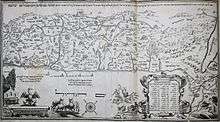Theory of Kashmiri descent from lost tribes of Israel
| Tribes of Israel |
|---|
 |
| The Tribes |
| Related topics |
The theory of Kashmiri descent from the lost tribes of Israel posits that the Kashmiri people of India and Pakistan originally descended from the Ten Lost Tribes.
History
The theory was first suggested by Abū Rayḥān al-Bīrūnī, the famous 11th-century Persian Muslim scholar. According to Al Biruni,"In former times the inhabitants of Kashmir used to allow one or two foreigners to enter their country, particularly Jews, but at present they do not allow any Hindus whom they do not know personally to enter, much less other people."[1]
François Bernier, a 17th-century French physician and Sir Francis Younghusband, who explored this region in the 1800s, commented on the similar physiognomy between Kashmiris and Jews,[1][2] including “fair skin, prominent noses,” and similar head shapes.[3][4][5]
In 1899[6] Mirza Ghulam Ahmad, founder of the Ahmadiyya movement, advanced the theory that Jesus had survived the crucifixion and traveled to Kashmir to find and preach to the lost tribes of Israel. Ahmad claimed that Jesus lived in Kashmir, had children, died at the age of 120,[7] and was buried in Srinagar.[8][9][4]
Baikunth Nath Sharga argues that, despite the etymological similarities between Kashmiri and Jewish surnames, the Kashmiri Pandits are of Indo-Aryan descent while the Jews are of Semitic descent.[10]
Basis in tribal names and toponymy
The theory is essentially based on the purported similarities between Kashmir place names and Hebrew words and phrases. The name Kashmir locally known as kasher itself is said to be based on the Hebrew word Kashir (Hebrew: כשיר), "like Syria".[8] The Kashmir valley, said to be the dwelling place of the Ten Lost Tribes, is called Bagh-I-Suleman (Garden of Solomon) in local parlance.[11] The connection between Kashmir and ancient Israel is strengthened further by such Kashmiri place names as "Tomb of Moses" and "Throne of Solomon". There is also a Kashmiri tradition that the 40 years of wandering in the desert actually covered the ground from Asia to Kashmir, and that Kashmir is in fact the Promised Land.[4]
The names of approximately 350 towns and villages in Kashmir bear some resemblance to place names in the Holy Land.[12] These include:
- Bandpoor (similar to Beth Peor)[6]
- Naboo Hill (similar to Mount Nebo)[6]
- Pishgah (similar to Mount Pisgah)[13][14]
- Mamre (similar to Mamre)[13][14]
See also
- Japanese-Jewish common ancestry theory
- Khazar theory of Ashkenazi ancestry
- Theories of Pashtun origin
References
- 1 2 "Kashmir". Jewish Virtual Library. 2012. Retrieved 28 October 2012.
- ↑ Quraishi, Humra (2004). Kashmir, The Untold Story. Penguin Books India. p. 37. ISBN 0143030876.
- ↑ Bhandari, Mohan C. (2006). Solving Kashmir. Lancer Publishers. p. 107. ISBN 8170621259.
- 1 2 3 Childress, David Hatcher (1991). Lost Cities of China, Central Asia and India (3rd ed.). Adventures Unlimited Press. p. 271. ISBN 0932813070.
- ↑ Bamzai, P. N. K (1994). Culture and Political History of Kashmir. 1. M.D. Publications Pvt. Ltd. p. 16. ISBN 818588031X.
- 1 2 3 Harinanda, Swami. Yoga and the Portal. Jai Dee Marketing. ISBN 0978142950.
- ↑ Turner, Richard Brent (2003). Islam in the African-American Experience (2nd ed.). Indiana University Press. p. 113. ISBN 0253216303.
- 1 2 Aḥmad, Bashīruddīn Maḥmūd (1980). Invitation to Ahmadiyyat: Being a Statement of Beliefs, a Rationale of Claims, and an Invitation, on Behalf of the Ahmadiyya Movement for the Propagation and Rejuvenation of Islam. Routledge. pp. 134–135. ISBN 0710001193.
- ↑ Ackerley, Chris; Clipper, Lawrence Jon (1984). A Companion to Under the Volcano. UBC Press. pp. 385–386. ISBN 0774801999.
- ↑ Kaw, M.K (2004). Kashmir and Its People: Studies in the Evolution of Kashmiri Society. APH Publishing. p. 51. ISBN 8176485373.
- ↑ Bhushan Sahai, Shashi (2010). The Hindu Civilisation: A Miracle of History. Gyan Publishing House. ISBN 8121210410.
- ↑ Allgood, Marcus (2009). What Da Vinci Really Didn't Want You to Know: The Jesus Conspiracy. AuthorHouse. p. 55. ISBN 1438990634.
- 1 2 Skolnick, Fred; Berenbaum, Michael (2007). Encyclopedia Judaica: Ja–Kas (2nd ed.). Macmillan Reference USA. p. 822. ISBN 0028659392.
- 1 2 "Midstream". Midstream. Theodor Herzl Foundation. 40: 20. 1994. Retrieved 28 October 2012.
External links
- "The Ten Tribes of Israel Who Came to Kashmir" (moshiach.com)